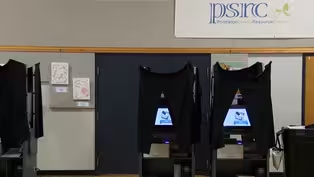NJ Spotlight News
NJ earthquakes: Why are there more of them now?
Clip: 8/7/2025 | 5m 14sVideo has Closed Captions
Interview: Dr. Andrew Gates, geologist and professor, Rutgers University
While some experts point to the ancient Ramapo Fault as the main seismic risk in New Jersey, Dr. Alexander Gates, a geologist and professor at Rutgers University has a different theory.
Problems playing video? | Closed Captioning Feedback
Problems playing video? | Closed Captioning Feedback
NJ Spotlight News is a local public television program presented by THIRTEEN PBS
NJ Spotlight News
NJ earthquakes: Why are there more of them now?
Clip: 8/7/2025 | 5m 14sVideo has Closed Captions
While some experts point to the ancient Ramapo Fault as the main seismic risk in New Jersey, Dr. Alexander Gates, a geologist and professor at Rutgers University has a different theory.
Problems playing video? | Closed Captioning Feedback
How to Watch NJ Spotlight News
NJ Spotlight News is available to stream on pbs.org and the free PBS App, available on iPhone, Apple TV, Android TV, Android smartphones, Amazon Fire TV, Amazon Fire Tablet, Roku, Samsung Smart TV, and Vizio.
Providing Support for PBS.org
Learn Moreabout PBS online sponsorshipWell, when you think of New Jersey, you don't typically think of a state prone to earthquakes, but they are happening and you may not even realize it.
The two most recent were just this week with 236 earthquakes total recorded in New Jersey since last year.
That includes the 4.8 magnitude one in Tewksbury last April and of course aftershocks, which has a lot of people wondering why they're happening now and whether we should expect more stronger quakes in the future.
To help us understand, we're joined by Alec Gates, a geology professor at Rutgers Newark whose research anticipated this pattern.
Alec, it's great to have you on the show.
A lot of questions here.
Many folks in your field have pointed to the ancient Ramapo fault lines as a usual suspect, but your research suggests something different.
What is that?
Yes, we find that the Ramapo fault is pretty much dead.
Instead, what we find is that there are mostly east-west trending faults that go all the way across from southern New Jersey all the way into southern New York and those are active.
What happens is that we get three or four earthquakes will occur over maybe a 12 month period normally.
This year everything's out the window.
Then they'll stop and the whole fault will become dead and then it'll shift to a different fault and then that will become active.
For example, there's a fault that runs right across New York City called the 125th Street Fault.
It was active in 2001, had about the same magnitude as what happened when the World Trade Center collapsed, about 2.3 in that neighborhood.
They had three earthquakes within one year.
It wasn't active before, hasn't been active since.
Then it shifts someplace else for several earthquakes there.
I wonder then why these faults like the one you just mentioned, the others that your research points to, haven't received more attention.
What type of cycle and pattern are you seeing?
Well, certainly in the past we haven't had many earthquakes.
We had modern seismic equipment went in about 1975.
From 1975 to 2024 we had a total of 350 earthquakes.
You saw what you just said.
Now we've had 236 in less than a year and a half.
All of a sudden we became from this slightly above normal in earthquakes to one of the top in the country earthquakes.
Yeah.
I mean, I know you've taken your students out into the field to look firsthand at some of these fault lines.
What does our landscape reveal about them and about the risks here?
Because of course, a lot of folks are wondering what happens next.
Yeah.
So as I said, you can see these fault lines, especially north of about Morristown, New Jersey all the way over to Staten Island.
South of there everything was covered with glacial till from the last ice age.
But north to there everything's scraped clean.
So those faults show up very nicely.
If you go on Google Earth, everything kind of goes northeast.
You'll see these.
They just come sharply across east, west, slightly to north, and they show up really nicely on Google Earth.
So that's how you can see them even from your house to see if you're on one of them.
So as far as why we have a lot of earthquakes now, we had a big earthquake back in 1884, and that was around Jamaica Bay area.
They estimated the magnitude to be about a 5.2.
Now considering what little damage that 4.8 did last year, you know, this one in 1884 toppled steeples in Rahway, New Jersey.
It knocked over chimneys off of houses.
It pulled houses off their foundations.
So I'm thinking that was a bit bigger.
It was probably 5.5 to 5.8.
So 140 years went by where we didn't have any big earthquakes at all, and normally we get them a little closer together than that.
And so this was the big one that we had been waiting for for 140 years.
I'm not sure we're going to get a whole lot bigger, but this is the biggest one we've had.
Okay.
Maybe it'll spark some interest in future geologists.
Alec Gates, thanks so much for sharing your insight.
Thank you.
Thank you for having me.
[music] (bell chimes)
What Trump cuts to 988 hotline mean for LGBTQ+ support
Video has Closed Captions
Clip: 8/8/2025 | 5m 1s | With 'Press 3' option gone, groups move to offer help (5m 1s)
76ers train and share memories with Camden campers
Video has Closed Captions
Clip: 8/7/2025 | 3m 43s | Sixers staffers returned to the Kroc Center’s day camp with Camden-area kids (3m 43s)
DNC to spend $1.5M on NJ governor's race
Video has Closed Captions
Clip: 8/7/2025 | 1m 21s | Money to go to Sherrill's field operations, as GOP voter registration rises (1m 21s)
Thousands of NJ kindergartners lag in measles vaccinations
Video has Closed Captions
Clip: 8/7/2025 | 5m 5s | Pediatricians warn of serious complications from the highly contagious disease (5m 5s)
Providing Support for PBS.org
Learn Moreabout PBS online sponsorship
- News and Public Affairs

Top journalists deliver compelling original analysis of the hour's headlines.

- News and Public Affairs

FRONTLINE is investigative journalism that questions, explains and changes our world.












Support for PBS provided by:
NJ Spotlight News is a local public television program presented by THIRTEEN PBS



